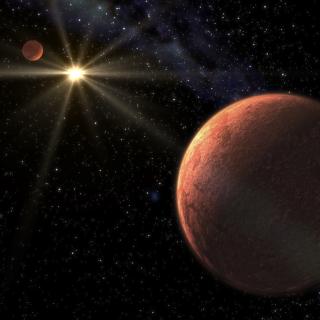Bibcode
Zhang, Z. H.; Pinfield, D. J.; Gálvez-Ortiz, M. C.; Homeier, D.; Burgasser, A. J.; Lodieu, N.; Martín, E. L.; Zapatero Osorio, M. R.; Allard, F.; Jones, H. R. A.; Smart, R. L.; López Martí, B.; Burningham, B.; Rebolo, R.
Bibliographical reference
Monthly Notices of the Royal Astronomical Society, Volume 479, Issue 1, p.1383-1391
Advertised on:
9
2018
Citations
22
Refereed citations
14
Description
We report the discovery of an esdL3 subdwarf, ULAS J020858.62+020657.0,
and a usdL4.5 subdwarf, ULAS J230711.01+014447.1. They were identified
as L subdwarfs by optical spectra obtained with the Gran Telescopio
Canarias, and followed up by optical-to-near-infrared spectroscopy with
the Very Large Telescope. We also obtained an optical-to-near-infrared
spectrum of a previously known L subdwarf, ULAS J135058.85+081506.8, and
reclassified it as a usdL3 subdwarf. These three objects all have
typical halo kinematics. They have Teff around 2050-2250 K,
-1.8 ≤ [Fe/H] ≤ -1.5, and mass around 0.0822-0.0833
M⊙, according to model spectral fitting and evolutionary
models. These sources are likely halo transitional brown dwarfs with
unsteady hydrogen fusion, as their masses are just below the
hydrogen-burning minimum mass, which is ˜ 0.0845 M⊙
at [Fe/H] = -1.6 and ˜ 0.0855 M⊙ at [Fe/H] = -1.8.
Including these, there are now nine objects in the `halo brown dwarf
transition zone', which is a `substellar subdwarf gap' that spans a wide
temperature range within a narrow mass range of the substellar
population.
Related projects

Very Low Mass Stars, Brown Dwarfs and Planets
Our goal is to study the processes that lead to the formation of low mass stars, brown dwarfs and planets and to characterize the physical properties of these objects in various evolutionary stages. Low mass stars and brown dwarfs are likely the most numerous type of objects in our Galaxy but due to their low intrinsic luminosity they are not so
Rafael
Rebolo López

Exoplanets and Astrobiology
The search for life in the universe has been driven by recent discoveries of planets around other stars (known as exoplanets), becoming one of the most active fields in modern astrophysics. The growing number of new exoplanets discovered in recent years and the recent advance on the study of their atmospheres are not only providing new valuable
Enric
Pallé Bago